Nutritional Intervention Strategies for Pressure Ulcer Patients
VerifiedAdded on 2022/10/16
|6
|1327
|161
Report
AI Summary
This report delves into the critical role of nutritional interventions in the management and healing of pressure ulcers, also known as bedsores. It highlights the formation of ischemic wounds due to prolonged pressure, particularly affecting tissues covering bone structures. The report emphasizes the impact of factors such as reduced mobility, friction, and malnutrition on ulcer development. It explores various nutritional strategies, including high-protein, high-energy diets, and arginine-enriched supplements, and their effectiveness compared to standard hospital diets. Several studies are discussed, including those by Cereda et al. (2015) and Dennis et al. (2005), which investigated the benefits of specialized diets and nutritional supplements. The report also underscores the importance of nurse-assisted movement, appropriate support surfaces, and monitoring serum albumin levels to prevent and manage pressure ulcers. It concludes by advocating for comprehensive care that combines nutritional interventions with external care methods and topical treatments to enhance patient outcomes. The report also mentions the JBI systematic review and its checklist, which are used to evaluate the effectiveness of the intervention.
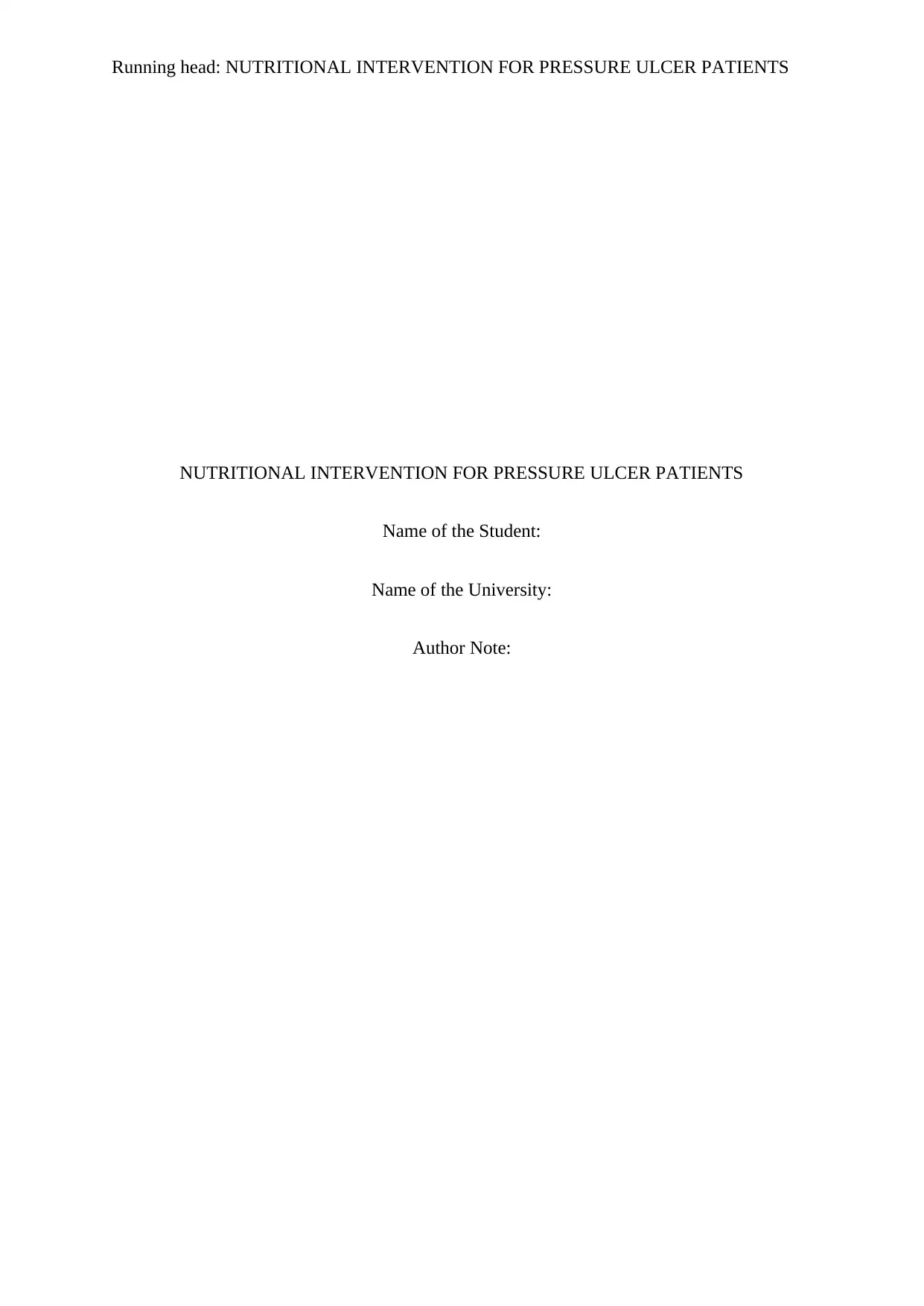
Running head: NUTRITIONAL INTERVENTION FOR PRESSURE ULCER PATIENTS
NUTRITIONAL INTERVENTION FOR PRESSURE ULCER PATIENTS
Name of the Student:
Name of the University:
Author Note:
NUTRITIONAL INTERVENTION FOR PRESSURE ULCER PATIENTS
Name of the Student:
Name of the University:
Author Note:
Paraphrase This Document
Need a fresh take? Get an instant paraphrase of this document with our AI Paraphraser
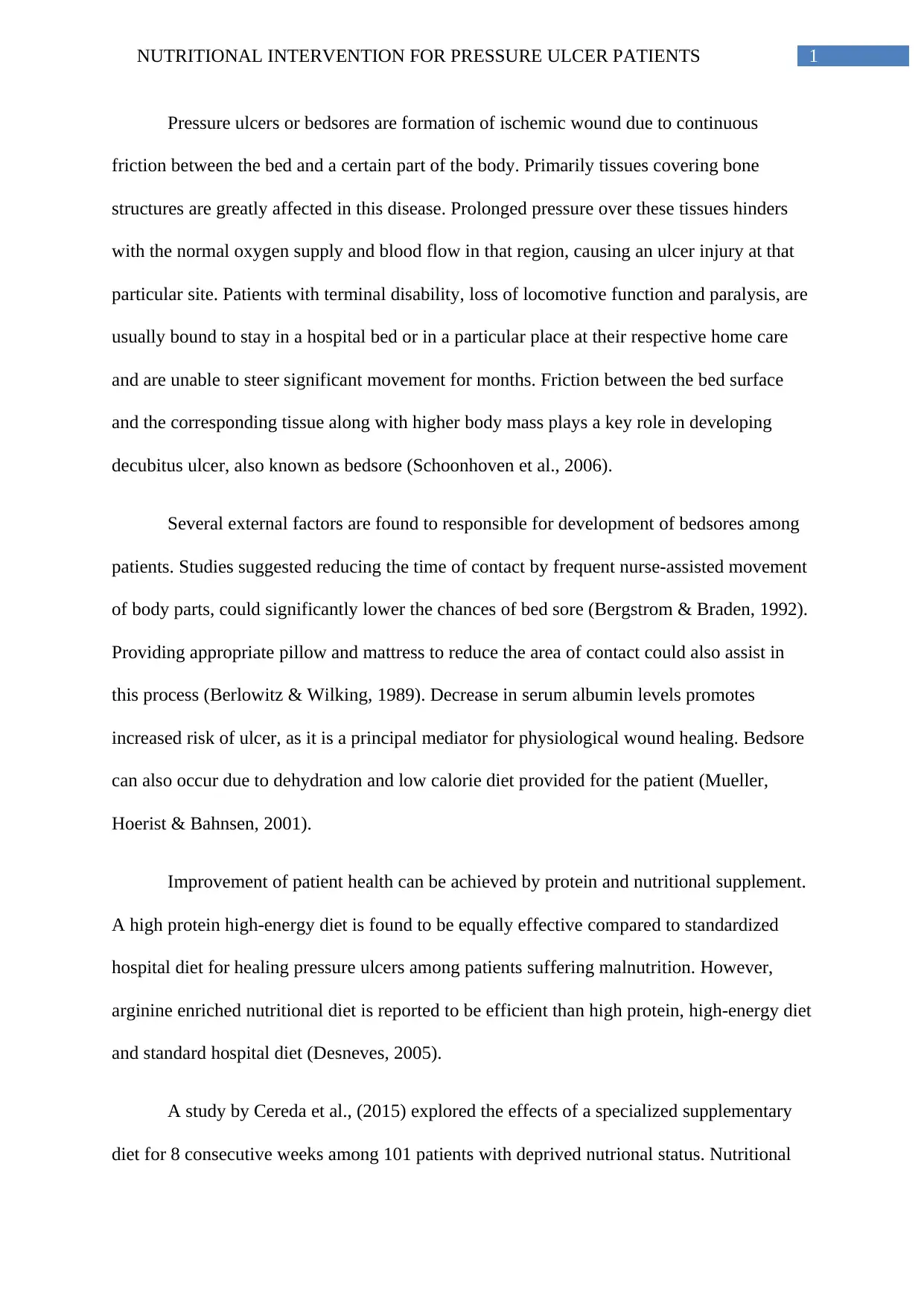
1NUTRITIONAL INTERVENTION FOR PRESSURE ULCER PATIENTS
Pressure ulcers or bedsores are formation of ischemic wound due to continuous
friction between the bed and a certain part of the body. Primarily tissues covering bone
structures are greatly affected in this disease. Prolonged pressure over these tissues hinders
with the normal oxygen supply and blood flow in that region, causing an ulcer injury at that
particular site. Patients with terminal disability, loss of locomotive function and paralysis, are
usually bound to stay in a hospital bed or in a particular place at their respective home care
and are unable to steer significant movement for months. Friction between the bed surface
and the corresponding tissue along with higher body mass plays a key role in developing
decubitus ulcer, also known as bedsore (Schoonhoven et al., 2006).
Several external factors are found to responsible for development of bedsores among
patients. Studies suggested reducing the time of contact by frequent nurse-assisted movement
of body parts, could significantly lower the chances of bed sore (Bergstrom & Braden, 1992).
Providing appropriate pillow and mattress to reduce the area of contact could also assist in
this process (Berlowitz & Wilking, 1989). Decrease in serum albumin levels promotes
increased risk of ulcer, as it is a principal mediator for physiological wound healing. Bedsore
can also occur due to dehydration and low calorie diet provided for the patient (Mueller,
Hoerist & Bahnsen, 2001).
Improvement of patient health can be achieved by protein and nutritional supplement.
A high protein high-energy diet is found to be equally effective compared to standardized
hospital diet for healing pressure ulcers among patients suffering malnutrition. However,
arginine enriched nutritional diet is reported to be efficient than high protein, high-energy diet
and standard hospital diet (Desneves, 2005).
A study by Cereda et al., (2015) explored the effects of a specialized supplementary
diet for 8 consecutive weeks among 101 patients with deprived nutrional status. Nutritional
Pressure ulcers or bedsores are formation of ischemic wound due to continuous
friction between the bed and a certain part of the body. Primarily tissues covering bone
structures are greatly affected in this disease. Prolonged pressure over these tissues hinders
with the normal oxygen supply and blood flow in that region, causing an ulcer injury at that
particular site. Patients with terminal disability, loss of locomotive function and paralysis, are
usually bound to stay in a hospital bed or in a particular place at their respective home care
and are unable to steer significant movement for months. Friction between the bed surface
and the corresponding tissue along with higher body mass plays a key role in developing
decubitus ulcer, also known as bedsore (Schoonhoven et al., 2006).
Several external factors are found to responsible for development of bedsores among
patients. Studies suggested reducing the time of contact by frequent nurse-assisted movement
of body parts, could significantly lower the chances of bed sore (Bergstrom & Braden, 1992).
Providing appropriate pillow and mattress to reduce the area of contact could also assist in
this process (Berlowitz & Wilking, 1989). Decrease in serum albumin levels promotes
increased risk of ulcer, as it is a principal mediator for physiological wound healing. Bedsore
can also occur due to dehydration and low calorie diet provided for the patient (Mueller,
Hoerist & Bahnsen, 2001).
Improvement of patient health can be achieved by protein and nutritional supplement.
A high protein high-energy diet is found to be equally effective compared to standardized
hospital diet for healing pressure ulcers among patients suffering malnutrition. However,
arginine enriched nutritional diet is reported to be efficient than high protein, high-energy diet
and standard hospital diet (Desneves, 2005).
A study by Cereda et al., (2015) explored the effects of a specialized supplementary
diet for 8 consecutive weeks among 101 patients with deprived nutrional status. Nutritional
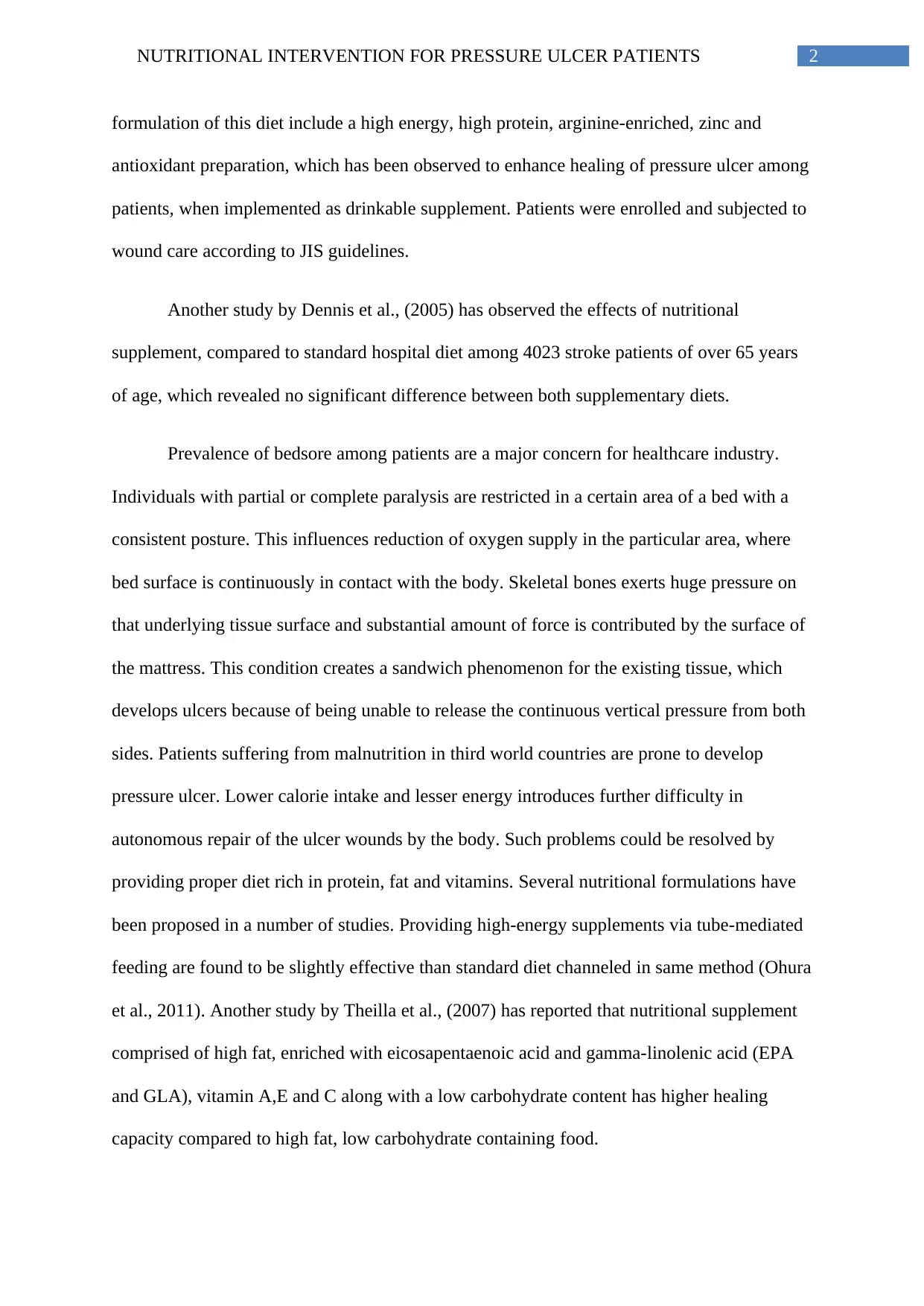
2NUTRITIONAL INTERVENTION FOR PRESSURE ULCER PATIENTS
formulation of this diet include a high energy, high protein, arginine-enriched, zinc and
antioxidant preparation, which has been observed to enhance healing of pressure ulcer among
patients, when implemented as drinkable supplement. Patients were enrolled and subjected to
wound care according to JIS guidelines.
Another study by Dennis et al., (2005) has observed the effects of nutritional
supplement, compared to standard hospital diet among 4023 stroke patients of over 65 years
of age, which revealed no significant difference between both supplementary diets.
Prevalence of bedsore among patients are a major concern for healthcare industry.
Individuals with partial or complete paralysis are restricted in a certain area of a bed with a
consistent posture. This influences reduction of oxygen supply in the particular area, where
bed surface is continuously in contact with the body. Skeletal bones exerts huge pressure on
that underlying tissue surface and substantial amount of force is contributed by the surface of
the mattress. This condition creates a sandwich phenomenon for the existing tissue, which
develops ulcers because of being unable to release the continuous vertical pressure from both
sides. Patients suffering from malnutrition in third world countries are prone to develop
pressure ulcer. Lower calorie intake and lesser energy introduces further difficulty in
autonomous repair of the ulcer wounds by the body. Such problems could be resolved by
providing proper diet rich in protein, fat and vitamins. Several nutritional formulations have
been proposed in a number of studies. Providing high-energy supplements via tube-mediated
feeding are found to be slightly effective than standard diet channeled in same method (Ohura
et al., 2011). Another study by Theilla et al., (2007) has reported that nutritional supplement
comprised of high fat, enriched with eicosapentaenoic acid and gamma-linolenic acid (EPA
and GLA), vitamin A,E and C along with a low carbohydrate content has higher healing
capacity compared to high fat, low carbohydrate containing food.
formulation of this diet include a high energy, high protein, arginine-enriched, zinc and
antioxidant preparation, which has been observed to enhance healing of pressure ulcer among
patients, when implemented as drinkable supplement. Patients were enrolled and subjected to
wound care according to JIS guidelines.
Another study by Dennis et al., (2005) has observed the effects of nutritional
supplement, compared to standard hospital diet among 4023 stroke patients of over 65 years
of age, which revealed no significant difference between both supplementary diets.
Prevalence of bedsore among patients are a major concern for healthcare industry.
Individuals with partial or complete paralysis are restricted in a certain area of a bed with a
consistent posture. This influences reduction of oxygen supply in the particular area, where
bed surface is continuously in contact with the body. Skeletal bones exerts huge pressure on
that underlying tissue surface and substantial amount of force is contributed by the surface of
the mattress. This condition creates a sandwich phenomenon for the existing tissue, which
develops ulcers because of being unable to release the continuous vertical pressure from both
sides. Patients suffering from malnutrition in third world countries are prone to develop
pressure ulcer. Lower calorie intake and lesser energy introduces further difficulty in
autonomous repair of the ulcer wounds by the body. Such problems could be resolved by
providing proper diet rich in protein, fat and vitamins. Several nutritional formulations have
been proposed in a number of studies. Providing high-energy supplements via tube-mediated
feeding are found to be slightly effective than standard diet channeled in same method (Ohura
et al., 2011). Another study by Theilla et al., (2007) has reported that nutritional supplement
comprised of high fat, enriched with eicosapentaenoic acid and gamma-linolenic acid (EPA
and GLA), vitamin A,E and C along with a low carbohydrate content has higher healing
capacity compared to high fat, low carbohydrate containing food.
⊘ This is a preview!⊘
Do you want full access?
Subscribe today to unlock all pages.

Trusted by 1+ million students worldwide
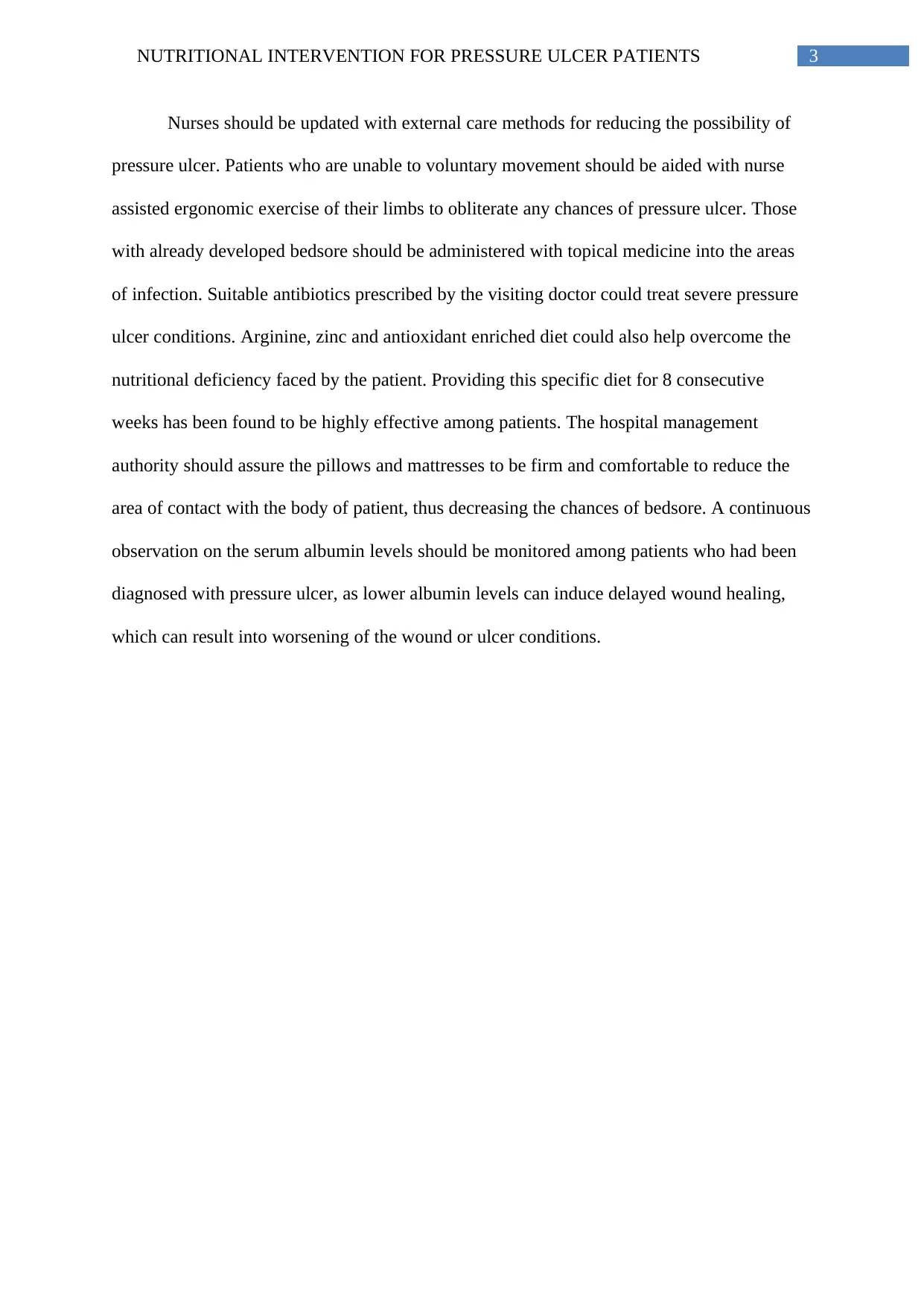
3NUTRITIONAL INTERVENTION FOR PRESSURE ULCER PATIENTS
Nurses should be updated with external care methods for reducing the possibility of
pressure ulcer. Patients who are unable to voluntary movement should be aided with nurse
assisted ergonomic exercise of their limbs to obliterate any chances of pressure ulcer. Those
with already developed bedsore should be administered with topical medicine into the areas
of infection. Suitable antibiotics prescribed by the visiting doctor could treat severe pressure
ulcer conditions. Arginine, zinc and antioxidant enriched diet could also help overcome the
nutritional deficiency faced by the patient. Providing this specific diet for 8 consecutive
weeks has been found to be highly effective among patients. The hospital management
authority should assure the pillows and mattresses to be firm and comfortable to reduce the
area of contact with the body of patient, thus decreasing the chances of bedsore. A continuous
observation on the serum albumin levels should be monitored among patients who had been
diagnosed with pressure ulcer, as lower albumin levels can induce delayed wound healing,
which can result into worsening of the wound or ulcer conditions.
Nurses should be updated with external care methods for reducing the possibility of
pressure ulcer. Patients who are unable to voluntary movement should be aided with nurse
assisted ergonomic exercise of their limbs to obliterate any chances of pressure ulcer. Those
with already developed bedsore should be administered with topical medicine into the areas
of infection. Suitable antibiotics prescribed by the visiting doctor could treat severe pressure
ulcer conditions. Arginine, zinc and antioxidant enriched diet could also help overcome the
nutritional deficiency faced by the patient. Providing this specific diet for 8 consecutive
weeks has been found to be highly effective among patients. The hospital management
authority should assure the pillows and mattresses to be firm and comfortable to reduce the
area of contact with the body of patient, thus decreasing the chances of bedsore. A continuous
observation on the serum albumin levels should be monitored among patients who had been
diagnosed with pressure ulcer, as lower albumin levels can induce delayed wound healing,
which can result into worsening of the wound or ulcer conditions.
Paraphrase This Document
Need a fresh take? Get an instant paraphrase of this document with our AI Paraphraser
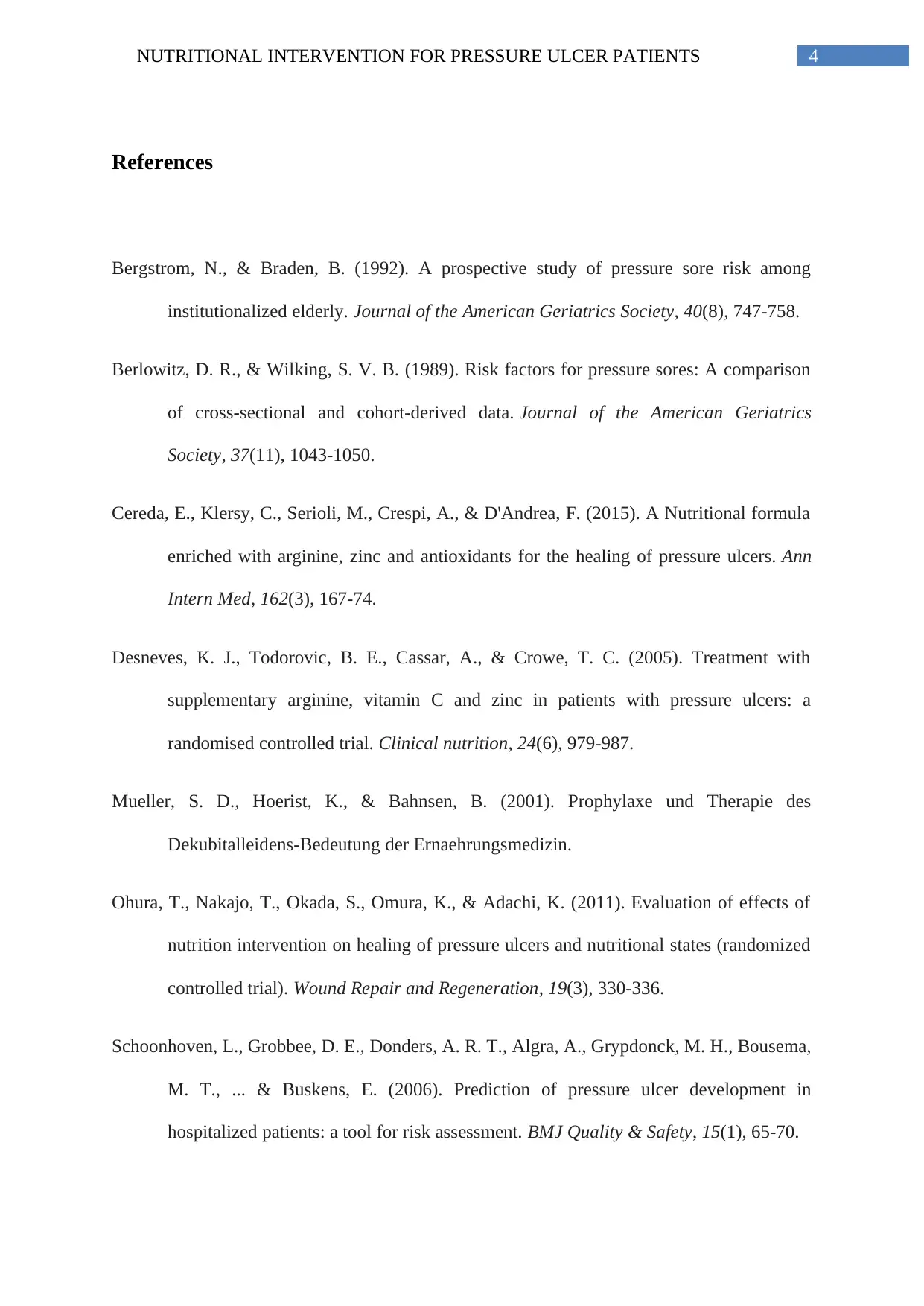
4NUTRITIONAL INTERVENTION FOR PRESSURE ULCER PATIENTS
References
Bergstrom, N., & Braden, B. (1992). A prospective study of pressure sore risk among
institutionalized elderly. Journal of the American Geriatrics Society, 40(8), 747-758.
Berlowitz, D. R., & Wilking, S. V. B. (1989). Risk factors for pressure sores: A comparison
of cross‐sectional and cohort‐derived data. Journal of the American Geriatrics
Society, 37(11), 1043-1050.
Cereda, E., Klersy, C., Serioli, M., Crespi, A., & D'Andrea, F. (2015). A Nutritional formula
enriched with arginine, zinc and antioxidants for the healing of pressure ulcers. Ann
Intern Med, 162(3), 167-74.
Desneves, K. J., Todorovic, B. E., Cassar, A., & Crowe, T. C. (2005). Treatment with
supplementary arginine, vitamin C and zinc in patients with pressure ulcers: a
randomised controlled trial. Clinical nutrition, 24(6), 979-987.
Mueller, S. D., Hoerist, K., & Bahnsen, B. (2001). Prophylaxe und Therapie des
Dekubitalleidens-Bedeutung der Ernaehrungsmedizin.
Ohura, T., Nakajo, T., Okada, S., Omura, K., & Adachi, K. (2011). Evaluation of effects of
nutrition intervention on healing of pressure ulcers and nutritional states (randomized
controlled trial). Wound Repair and Regeneration, 19(3), 330-336.
Schoonhoven, L., Grobbee, D. E., Donders, A. R. T., Algra, A., Grypdonck, M. H., Bousema,
M. T., ... & Buskens, E. (2006). Prediction of pressure ulcer development in
hospitalized patients: a tool for risk assessment. BMJ Quality & Safety, 15(1), 65-70.
References
Bergstrom, N., & Braden, B. (1992). A prospective study of pressure sore risk among
institutionalized elderly. Journal of the American Geriatrics Society, 40(8), 747-758.
Berlowitz, D. R., & Wilking, S. V. B. (1989). Risk factors for pressure sores: A comparison
of cross‐sectional and cohort‐derived data. Journal of the American Geriatrics
Society, 37(11), 1043-1050.
Cereda, E., Klersy, C., Serioli, M., Crespi, A., & D'Andrea, F. (2015). A Nutritional formula
enriched with arginine, zinc and antioxidants for the healing of pressure ulcers. Ann
Intern Med, 162(3), 167-74.
Desneves, K. J., Todorovic, B. E., Cassar, A., & Crowe, T. C. (2005). Treatment with
supplementary arginine, vitamin C and zinc in patients with pressure ulcers: a
randomised controlled trial. Clinical nutrition, 24(6), 979-987.
Mueller, S. D., Hoerist, K., & Bahnsen, B. (2001). Prophylaxe und Therapie des
Dekubitalleidens-Bedeutung der Ernaehrungsmedizin.
Ohura, T., Nakajo, T., Okada, S., Omura, K., & Adachi, K. (2011). Evaluation of effects of
nutrition intervention on healing of pressure ulcers and nutritional states (randomized
controlled trial). Wound Repair and Regeneration, 19(3), 330-336.
Schoonhoven, L., Grobbee, D. E., Donders, A. R. T., Algra, A., Grypdonck, M. H., Bousema,
M. T., ... & Buskens, E. (2006). Prediction of pressure ulcer development in
hospitalized patients: a tool for risk assessment. BMJ Quality & Safety, 15(1), 65-70.
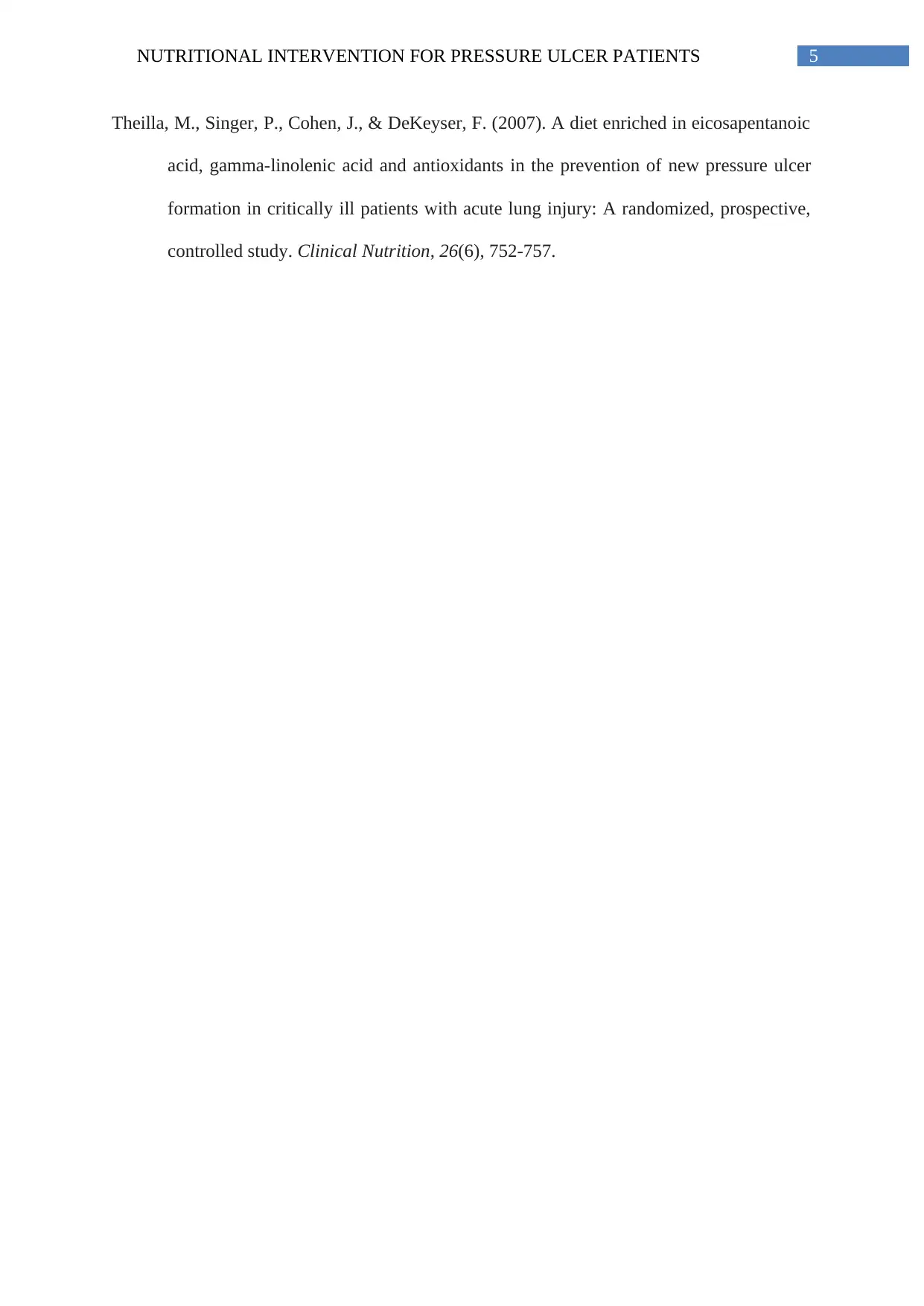
5NUTRITIONAL INTERVENTION FOR PRESSURE ULCER PATIENTS
Theilla, M., Singer, P., Cohen, J., & DeKeyser, F. (2007). A diet enriched in eicosapentanoic
acid, gamma-linolenic acid and antioxidants in the prevention of new pressure ulcer
formation in critically ill patients with acute lung injury: A randomized, prospective,
controlled study. Clinical Nutrition, 26(6), 752-757.
Theilla, M., Singer, P., Cohen, J., & DeKeyser, F. (2007). A diet enriched in eicosapentanoic
acid, gamma-linolenic acid and antioxidants in the prevention of new pressure ulcer
formation in critically ill patients with acute lung injury: A randomized, prospective,
controlled study. Clinical Nutrition, 26(6), 752-757.
⊘ This is a preview!⊘
Do you want full access?
Subscribe today to unlock all pages.

Trusted by 1+ million students worldwide
1 out of 6
Related Documents
Your All-in-One AI-Powered Toolkit for Academic Success.
+13062052269
info@desklib.com
Available 24*7 on WhatsApp / Email
![[object Object]](/_next/static/media/star-bottom.7253800d.svg)
Unlock your academic potential
Copyright © 2020–2025 A2Z Services. All Rights Reserved. Developed and managed by ZUCOL.



